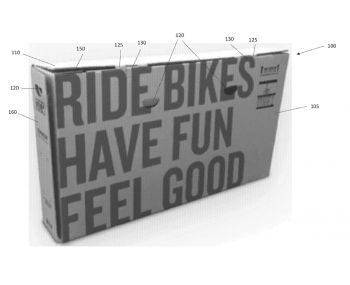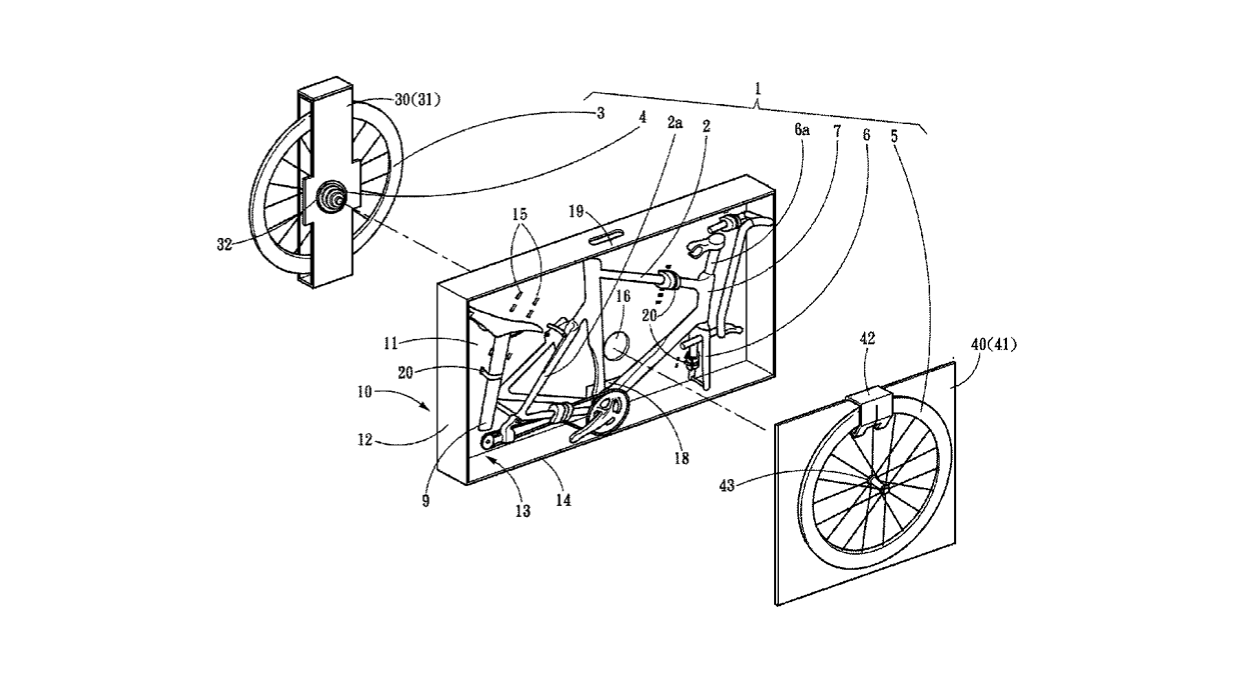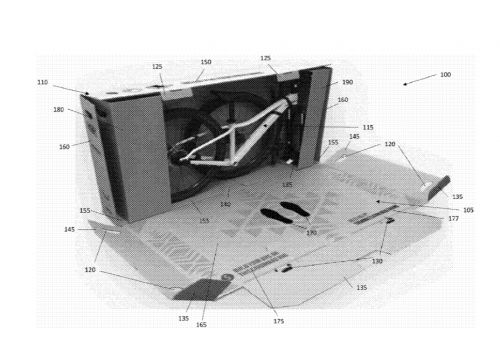A version of this article ran in the Oct. 1 issue of Bicycle Retailer and Industry News.
Update, Oct. 21: Trek has clarified that while the company has been shipping in China for about 3 years, the box featured in the patent was not used until after the filing date of the patent.
By Alan Coté
Bike boxes might only be outdone by empty coffee cups as the most common clutter in the work areas of shops. While the enormous cartons don’t get much attention — particularly compared to what’s inside them — bike boxes and related packaging use significant amounts of cardboard and other materials. Recently, there’s been consideration of minimizing and optimizing packing materials used on shipping new bikes from brands Trek and VAAST. On a different front, manufacturers are re-thinking box designs to make the packaging easier for consumers to unpack and assemble a new bicycle.
A box designed for consumers is precisely what Trek has targeted in a recent patent application, Bicycle Packaging System. The Detailed Description section of the patent filing is surprisingly clear (unlike the broad language common in patent descriptions) about this: “Described herein are methods and systems for packaging bicycles that are to be directly delivered to end users. The proposed packaging systems are designed to be user friendly, and do not require the user to lift the bicycle frame or other bicycle components out the top of the box.”
A box that opens on the side, not at the top, is the difference that jumps out most between Trek’s box design and a conventional bike box, as seen in the above drawing from the patent application. In addition to eliminating the awkward lift-it-out-of-the-box maneuver that every shop mechanic knows so well, Trek touts another advantage: “The folded down front of the packaging system also acts as a work surface that provides the user with an area to assemble the bicycle, while protecting the floor from scratches, grease, etc.”
The design may include a visual clue like footprints (indicia 170 in the patent drawing), to further drive the idea home to consumers. Such a built-in work surface may serve consumers well – but not shops. While new a new bike typically goes straight from box to repair stand in a shop, space constraints in assembly areas could make side opening boxes cumbersome for mechanics. That means Trek would need to warehouse boxed bikes in two categories: those going to shops, and those shipping consumer-direct.
Perhaps you’re wondering how it’s possible to patent a side-opening box. The broad idea of a side-opening box has been done before, and is therefore “prior art” in patent terms. It’s the claims of a patent that define the intellectual property protected – and often very particular details must be included in patent claims to work around prior art. In Trek’s case, including a tire wedge with a slot within the rear wheel support, in combination with other box features, seems to be key to patentability (Note: at press time, the patent application had not received an Allowance Notice, so this is speculative based on patent documents examined).

Consumer-direct brand Canyon has filed numerous patent applications for bike boxes, both in the U.S. and Europe. A common element to some of Canyon’s patent filings is the inclusion of particular “fixing” or “stabilizing” elements within the box — these for securing the rear wheel, stem (attached to the fork, rather than removed or affixed to the handlebars), and more. One aspect claimed is for a small parts container as part of the stabilizing elements for the rear wheel. These patent claims seem equally as applicable to cartons for shop-bound bicycles as for consumer-direct bikes.
In other patent applications, Canyon shows a box that opens at its end, with the bicycle mounted to a base element that can be slid out of the box — like Trek, seeking to avoid the lift-out-the-top operation. As anyone who’s ever unpacked a bike knows, such a lift may even require two people: one to raise the bike, another to hold the box down – especially for a first-timer. This becomes more relevant with ebikes, which in most cases are substantially heavier than acoustic bikes.
Canyon’s patent application titled Bicycle Transport Container and Inside-Leg Measurement System brings a new use to the common carton. The design includes an inseam measuring system that’s printed on to cardboard, and can be included as part of the base element, or elsewhere. Also included are a slot and a projection element. The projection element is placed in the slot, and the rider straddles it to measure inseam. Corresponding measurements are marked on the seatpost.
Giant also received a patent in 2018 for a packaging structure that allowed a bike to "be directly exhibited through the exhibition opening and be sold to eliminate conventional complications of box opening and assembly for exhibition and post-exhibition re-boxing. The bicycle frame is placed in the exhibition box for carrying outdoors to achieve objects of recycling and reducing costs and burden on the environment." The Giant patent appears to be more concerned with minimizing waste than consumer bike assembly, although it does claim to make it easier to get the bike out of the box, which is a feature anyone can appreciate.
A brief patent search shows numerous patent filings over the last 20 years for reusable travel-style bike cases and bags, but very little in the area of bike cartons for OE shipping purposes. The common bike box would seem to leave little room for patentable inventing, and the cost of obtaining a patent is in the low five figures at a minimum. But Trek and Canyon have decided the juice is worth the squeeze in pursuing intellectual property for bike packaging.
Editor's note: On Oct. 11, the consumer site WheelBased.com published an article about Trek's patent application. Trek Bicycle responded to that article on WheelBased's Instagram account, saying, "Here's some background information that might be helpful. This is a bike box that we have been shipping in China for around three years. We use this box in China so we’re able to provide access to Trek products across a huge region with a smaller retail presence for a market with 1.4 billion people. It’s helped us get our products to remote areas where in some places there is little to no bicycle retail. We’re not currently planning on expanding its use beyond China."
Trek spokesman Eric Bjorling later clarified to BRAIN that while the company has been shipping in China for about 3 years, the box featured in the patent was not used until after the filing date of the patent.
Alan Coté is a Registered Patent Agent and principal of Green Mountain Innovations LLC. He’s a past contributing writer to Bicycling, Outside, and other magazines, and is a former elite-level racer. He also serves as an expert witness in bicycle-related legal cases. Nothing in this article should be considered legal advice.


